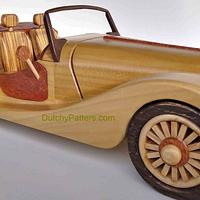Share your craft projects
Make new craft buddies
Ask craft questions
Blog your craft journey

shipwright
2135 posts
and
113 followers
in almost 12 years
in almost 12 years
Shipyard Memories #13: Two Cape Scott 36's: Cold Molded Construction
This is
part 13
in a
22 part
series:
Shipyard Memories
...
-
The Catboats: Framed Plywood Construction, Finished Photos and Sailing.
-
Two Cape Scott 36's: Cold Molded Construction
-
Cold Molded Planking
...
...
- The Catboats: Framed Plywood Construction, Finished Photos and Sailing.
- Two Cape Scott 36's: Cold Molded Construction
- Cold Molded Planking
...
This is the third in a series of blogs on the different types of wooden boat construction I've done. The first two covered traditional carvel planking and framed plywood construction. This one will concentrate on a method called "cold molding". Cold molding refers to the fashioning of a hull form by gluing up layers of thin planking in different orientations much like a sheet of plywood is made, but in this case it takes the shape of a boat.
There are several methods by which a cold molded hull can be built. There can be several very thin layers or fewer thicker ones. There can be opposing diagonals over a form of temporary molds, bulkheads and permanent battens, or the hull can be laid up over a solid re-usable mold and removed as a shell, or it can be built with an initial layer of strip planking covered over with two or more thin diagonal layers. There are also combinations and modifications to all of the above. The important thing is that they are all glued up monocoque hulls that exhibit very high strength to weight ratios.
Olfara and Stevador (see my projects) were built with three layers (1/4") of diagonal planking over temporary molds, bulkheads and permanent battens. Olfara's planking is all Honduras Mahogany while Stevador has two layers of Sitka Spruce (to reduce weight and give a light color to the interior) and one Mahogany on the outside for durability.
The first photo shows the oak plywood bulkheads and behind them, the temporary molds, ready to be assembled on the strongback timbers that will form the rigid foundation required to keep everything in line. The Oak plywood has had two coats of epoxy sealer to protect the thin surface veneer during construction.

Here the bulkheads and molds are being set up on the strongback timbers, trued up to be plumb, level and square. As you can see these hulls will be built upside down. The messy looking pile over by the wall is 6000 lbs of lead sheathings stripped from old electrical cable. I'll never use cable sheathings again. We'll come to that later.

Now the stern timber is being laminated up out of sixteen layers of 1/4" H. Mahogany. This was done in stages and required MANY more clamps than you see here. We often took most of the clamps off after several hours, when the epoxy was almost fully cured but left enough to avoid stressing the joint until full cure was obtained. The heavy blocking is just a form and was removed as soon as the stern timber was cured up.

The stem was a much easier lamination and was made up of 3/4" layers. Again there were many more clamps than seen here. I think this picture is actually a dry fitting.

Here the permanent battens are being fitted (Yellow Cedar) and the stem is being faired and shaped to match their changing angles. The bulkheads have been notched to accept the battens and the battens will be glued into them, making them rigid structural members. The temporary molds are smaller and the battens rest on top of them.

This is basically the same thing as the last photo but at the stern. It was a truly challenging stern to build. The rough shaping you see here was done with a power plane. Once all the battens are in place the final fairing is done with a disc sander.

Final shot for today. This one belongs somewhere between the last few but shows the whole boat. The backbone (stem, keelson and stern timber) is in place but not yet faired in to accept the skin, the sheer clamps have been added and the battens are being installed.

Next time , Planking cold molding style.
Thanks for dropping by. hope you're having fun. I still am.
Comments, questions and critiques are always welcome.
Thanks again.
Paul
The early bird gets the worm but its the second mouse that gets the cheese.
2 Comments
Interesting write up Paul.
Main Street to the Mountains










